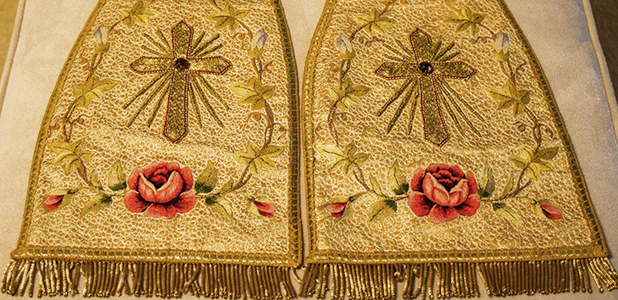Mother Caroline and the liturgical arts
On December 15, 1850, Mother Caroline Friess, foundress of the School Sisters of Notre Dame in North America, three sisters and a candidate arrived in Milwaukee. Those first months were difficult, in part, because money was always in short supply. The sisters could not afford to properly heat the motherhouse, so they were often freezing. “Their board was no less meager; meat and bread were often consumed a long time before bills were paid.” In addition to opening their first school and getting the former motherhouse organized, Mother Caroline had to figure out how to make enough money to support herself and the sisters.

She could not rely on the archdiocese or the parishes for assistance, because they were also struggling financially. She could not expect to receive “dowries” from prospective candidates because most came from poor families. The sisters were semi-cloistered during this period, so they were only allowed to leave the motherhouse for very specific reasons, therefore working outside the home or soliciting donations were not options.
Instead, Mother Caroline put her skills and those of the sisters to good use. Shortly after arriving in Milwaukee, Sister Emmanuel Schmid opened a music department in the former motherhouse and, “in a short time her pupils were sufficient in number to fill all the teaching hours of the day.” The sisters also earned extra income by giving French lessons.
Milwaukee’s bishop, John Martin Henni, had “refined taste,” and insisted on beautifying the diocese’ churches. As a result, local pastors asked the sisters to make artificial flowers, vestments, altar linens and other liturgical items. Eventually, Mother Caroline was able to open a flower-making department at the motherhouse. The sisters engaged in making artificial flowers that were used to decorate church altars.
Mother Caroline initially offered to make linings and curtains for the church tabernacles free of charge, but she did accept payment for the materials needed to make these items. She later announced that the sisters would accept orders for altar linens and vestments. She opened the tapestry room at the motherhouse where sisters hand sewed and embroidered beautiful vestments, burses, pals, banners and altar cloths.
Needlework was an important part of a German girl’s education in the 1800s. Blessed Theresa of Gerhardinger, foundress of the School Sisters of Notre Dame, believed that needlework helped children focus their attention and she directed that the sisters teach needlework 10 hours a week. Mother Caroline, in particular, was very skilled at embroidery. Her grandmother taught her to sew and she learned church embroidery while at school with the Benedictine sisters. It was not unusual for Mother Caroline to embroider vestments in her spare time and some of her work is preserved today in the Heritage Room at Notre Dame of Elm Grove, Elm Grove, Wisconsin.
The tapestry room did not make enough money to support the sisters, but it did provide a significant source of income. For example, an account from the former Milwaukee motherhouse, dated 1850-1855, shows that the sisters received $96.50 from French tutoring, $292 from piano lessons and $686.50 from needlework.
Mother Caroline started the tapestry room as a way to make money to support the sisters. She could not have known that the work she started would continue in various forms today. The sisters working in the Liturgical Fabric Arts program, which opened at Sancta Maria in Ripa in St. Louis in 1898, continue to make liturgical pieces for churches around the country.
Liturgical Fabric Arts today
By Sister Josephine Niemann
Liturgical Fabric Arts was originally called the Ecclesiastical Department. When I was in formation, it was located on the third floor in the northeast corner of the former motherhouse, known now as the Theresa Center, at Sancta Maria in Ripa in St. Louis. Then as a candidate, in the 1950s, the Caroline Center was built. The following year the Ecclesiastical Department moved to its current location in the Caroline Center. There were a handful of directors over the years, but Sister Rose Peterschmidt was the one who changed the name to Liturgical Fabric Arts.
In 1983, I came home from Africa and was assigned to the ministry of art full time with my services available to any department within the Theresa Center. At that time, Sister Rose asked me to design some chasubles and stoles and often called me for advice on designs she created. Within a year’s time I realized the greatest need for my talents was in Liturgical Fabric Arts. So, I began spending most of my time there. Since I have worked in the department, I have tried to offer banners, chasubles and stoles with contemporary designs that distinguish our work from the many traditional offerings.
Learn more about Liturgical Fabric Arts.
Learn more about the SSND and needlework on SturdyRoots.com.
Sources from Archives:
- Venerable Mother Caroline Friess: A Sketch of her Life and Character, by P.M. Abbelen, 1917
- Mother Caroline and the School Sisters of Notre Dame in North America, by A School Sister of Notre Dame, 1928.
- “History of the Tapestry Room,” by Sisters Adeloga Schmidmeier, Margarita Schneider and Marlita Miller, c. 1981.